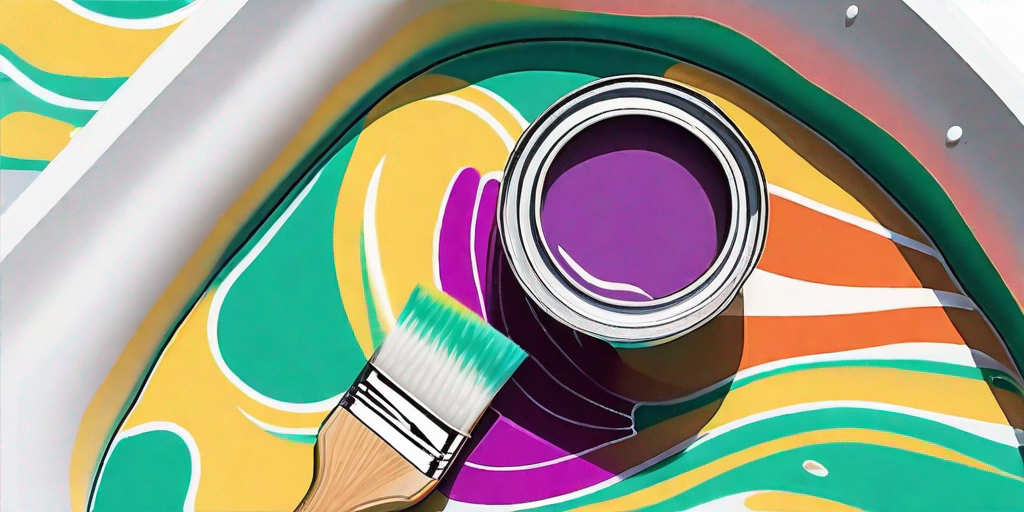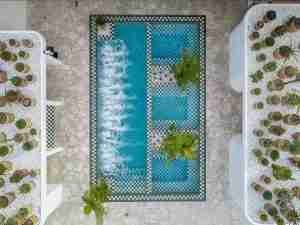If you’re a proud pool owner in Australia, you know how important it is to keep your pool in top condition. Over time, wear and tear can leave your pool looking dull and faded. One way to rejuvenate your fibreglass pool is by giving it a fresh coat of paint. In this article, we will guide you through the process of painting a fibreglass pool and share some valuable tips along the way.
Understanding Fibreglass Pools
Fibreglass pools are a popular choice for many Australian homeowners. They are made of a composite material consisting of small glass fibers embedded in plastic resin. This composition gives fibreglass pools their durability and strength, making them resistant to cracks and leaks.
But what exactly makes fibreglass pools so durable? Let’s take a closer look at their composition.
The Composition of Fibreglass Pools
A fibreglass pool consists of several layers. The outermost layer is the gel coat, which provides the pool’s smooth and glossy finish. This layer not only enhances the pool’s aesthetic appeal but also acts as a protective barrier against UV rays, chemicals, and other external factors that could potentially damage the pool.
Beneath the gel coat is the structural layer, made of fibreglass reinforced with resin. This layer gives the pool its strength and stability. The fibreglass, consisting of tiny glass fibers, adds rigidity to the pool, while the resin acts as a binding agent, holding the fibers together. This combination creates a solid structure that can withstand the pressure exerted by the water and the surrounding soil.
Furthermore, the resin used in fibreglass pools is specially formulated to resist corrosion and degradation caused by exposure to water and chemicals. This ensures that the pool remains in excellent condition for years to come.
Benefits of Fibreglass Pools
There are several advantages of choosing a fibreglass pool over other pool materials. One of the key benefits is the low maintenance required. Unlike concrete or vinyl pools, fibreglass pools have a non-porous surface, which means they are less prone to staining and require fewer chemicals to maintain water balance. This not only saves you time and effort but also reduces the overall cost of pool maintenance.
Moreover, fibreglass pools are highly resistant to algae growth. The smooth surface of the pool makes it difficult for algae to adhere, making cleaning and maintenance a breeze. This not only keeps the pool looking pristine but also ensures that the water remains safe and hygienic for swimming.
Another advantage of fibreglass pools is their smooth surface. Unlike concrete pools, which can be rough and abrasive, fibreglass pools offer a comfortable swimming experience. The smooth surface is gentle on the skin, reducing the risk of scratches and abrasions. This is especially beneficial for families with young children who love to splash around in the pool.
Lastly, fibreglass pools come in a variety of shapes, sizes, and designs, allowing homeowners to choose a pool that perfectly suits their preferences and complements their outdoor space. Whether you prefer a traditional rectangular pool or a more contemporary freeform design, there is a fibreglass pool option for everyone.
So, if you’re looking for a durable, low-maintenance, and aesthetically pleasing pool, fibreglass is definitely worth considering. Its composition and unique features make it a top choice among homeowners across Australia.
Preparing Your Pool for Painting
Prior to painting, it’s essential to assess the condition of your pool. Look out for any cracks, chips, or delamination on the surface. These issues should be addressed before proceeding with the painting process.
Assessing the Pool’s Condition
Thoroughly inspect your pool for any signs of damage. If you notice any cracks or chips, they will need to be repaired before painting. Delamination, which is separation between the structural layer and the gel coat, should also be fixed to ensure a smooth and even paint application.
Cleaning and Sanding the Pool Surface
Once the pool is in good condition, it’s time to prepare the surface for painting. Start by cleaning the pool using a mild detergent and a soft brush. This will remove any dirt, grime, or chemicals that may interfere with the paint’s adhesion. After cleaning, sand the surface with fine-grit sandpaper to create a rough texture that will help the paint adhere better.
Choosing the Right Paint for Fibreglass Pools
Selecting the appropriate paint for your fibreglass pool is crucial to achieving a long-lasting and aesthetically pleasing result.
Types of Pool Paint
There are two common types of paint used for fibreglass pools: epoxy and acrylic. Epoxy paint provides excellent durability and resistance to chemicals, making it a popular choice for high traffic pools. Acrylic paint, on the other hand, offers superior color retention and UV resistance, making it ideal for outdoor pools exposed to harsh sunlight.
Factors to Consider When Choosing Paint
Before making a decision, consider factors such as your pool’s location, expected usage, and maintenance routine. Consulting with a pool professional can also help you determine the best paint option for your specific needs.
The Painting Process
Now that you’ve prepared the pool and selected the paint, it’s time to dive into the painting process.
Applying the Primer
Before applying the paint, it’s crucial to apply a primer specifically designed for fibreglass pools. The primer prepares the surface, enhances adhesion, and ensures an even application of the paint.
Painting Techniques for Fibreglass Pools
When it comes to painting a fibreglass pool, there are two primary techniques: rolling and spraying. Rolling involves using a roller to apply the paint, while spraying requires a paint sprayer. Both techniques can yield excellent results when done correctly. Choose the technique that you are most comfortable with or seek professional assistance for a flawless finish.
Maintaining Your Painted Fibreglass Pool
Now that your pool has been beautifully painted, it’s important to maintain it to ensure its longevity and aesthetic appeal.
Regular Cleaning and Maintenance Tips
Regularly clean your pool using a pool brush or vacuum to remove any dirt or debris that may accumulate on the painted surface. Additionally, monitor the pool’s chemical balance and adjust it as needed to prevent staining or discoloration of the paint.
When to Repaint Your Pool
Over time, the paint on your fibreglass pool may start to fade or show signs of wear. If you notice significant fading, chipping, or peeling, it’s time to consider repainting. Repainting your pool not only restores its appearance but also provides an opportunity to address any underlying issues that may have developed.
By following these guidelines and investing time and effort into painting and maintaining your fibreglass pool, you can enjoy a beautiful and inviting swimming environment for years to come.




